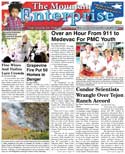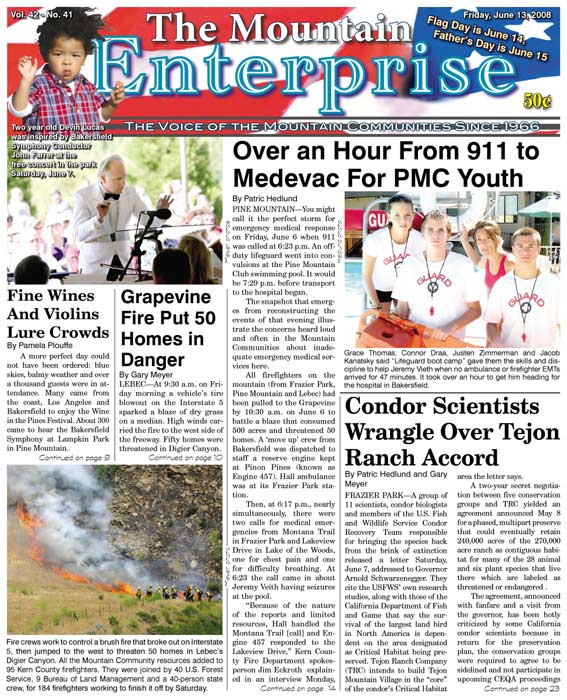![A California condor soars over its range, bearing monitoring transmitters [Noel Snyder photo].](https://mountainenterprise.com/fds/images/story/fs_3050.jpg)
A California condor soars over its range, bearing monitoring transmitters [Noel Snyder photo].
By Patric Hedlund and Gary Meyer
FRAZIER PARK-A group of 11 scientists, condor biologists and members of the U.S. Fish and Wildlife Service Condor Recovery Team responsible for bringing the species back from the brink of extinction released a letter Saturday, June 7, addressed to Governor Arnold Schwarzenegger. They cite the USFWS’ own research studies, along with those of the California Department of Fish and Game that say the survival of the largest land bird in North America is dependent on the area designated as Critical Habitat being preserved. Tejon Ranch Company (TRC) intends to build Tejon Mountain Village in the core of the condor’s Critical Habitat area the letter says.
A two-year secret negotiation between five conservation groups and TRC yielded an agreement announced May 8 for a phased, multipart preserve that could eventually retain 240,000 acres of the 270,000 acre ranch as contiguous habitat for many of the 28 animal and six plant species that live there which are labeled as threatened or endangered .
The agreement, announced with fanfare and a visit from the governor, has been hotly criticized by some California condor scientists because in return for the preservation plan, the conservation groups were required to agree to be sidelined and not participate in upcoming CEQA proceedings or to oppose three TRC developments: Tejon Mountain Village (3,400 homes and several resort hotels within the condor’s Critical Habitat), the Centennial project (23,000 homes and commercial-industrial parks) plus additional development adjacent to the Tejon Industrial Complex at the northern base of the Grapevine.
Further disclosures, reported by Associated Press last week, revealed that Tejon Ranch Company has made significant payments to condor scientists for their "opinion" on the TRC conservation plan. The payments were said to require the scientists to sign a contract agreeing not to oppose the company’s development plans, even if they feel the plans may harm the condor’s chances for survival. The arrangement has been called "buying silence" by those opposed to the TRC developments.
Concern has been raised that perhaps there would be no California condor expert voices left to speak candidly in the upcoming public process. At issue is how the developments would impact the endangered species that has drawn the most sustained public and private involvement in America.
In an opinion article for the Bakersfield Californian, on June 8, zoologist Peter Bloom, "who directed the effort to capture all of the wild free-flying California condors captured between 1982 and 1987," says he agreed to Tejon Ranch’s offer for payment in exchange for his opinion because "these were not small tasks [and] Tejon Ranch appropriately paid for our time and related expenses."
Bloom says that to suggest the scientists who agreed to the Tejon deal were not completely free to agree or disagree publicly "would be totally false."
But Dr. Noel F. R. Snyder, an ornithologist who was the lead scientist for the Condor Recovery Program from 1980 to 1986, says he had a different experience with Tejon Ranch.
Dr. Snyder has published 76 papers—of which 35 are about condors—plus 15 books and monographs.
Snyder received a call from Dudek, a consulting firm for Tejon Ranch. "There were a lot of parties on the conference call," Snyder recalled during a telephone interview with The Mountain Enterprise on June 11.
"They asked me if I would come out to California and review a technical report by Peter Bloom." The firm offered to pay Snyder $3,000 for the day, but there was a catch. The contract, according to Snyder and his attorney, could prohibit Snyder from testifying in court, should the Tejon Ranch deal find itself the object of a lawsuit.
"They said it was just a standard agreement," Snyder said, "but I had to tell them I could not sign it and could not consult for them."
The contract was provided to The Mountain Enterprise to review. The portion which made Snyder uncomfortable reads, "Subconsultant agrees that all original data, information, and materials, including computer software, computer data bases, computer software documentation, specifications, designs, drawings, reports, blueprints, generated in the performance of this Agreement and data and information which are specified to be delivered or which are in fact, delivered pursuant to this Agreement shall be and remain the sole property of DUDEK."
"They said it only referred to materials, maps, reports, et cetera, but my lawyer advised that it could go well beyond that," Snyder said.
In his June 8 article, Bloom writes about the reason he and his team members Lloyd Kiff and Bob Risebrough joined with Tejon Ranch: "We were willing to give our input and assessment of the report because of our concern for the condor and because Tejon Ranch as the largest contiguously owned private property in the state has a particularly important role to play in expanding the condor’s range from the coastal mountains to the southern Sierra Nevada."
The scientists and condor experts who signed the letter to Governor Schwarzenegger, protesting the Tejon Ranch deal are: Dr. Noel F. R. Snyder, David A. Clendenen, Janet A. Hamber, Dr. Eric V. Johnson, Dr. Allan Mee, Dr. Vicky J. Meretsky, Bruce K. Palmer, Anthony Prieto, Dr. Arthur C. Risser, Jr., Fred C. Sibley and William D. Toone. All are condor biologists.
They write in their letter: "The recovering condor population is again occupying Critical Habitat on Tejon with frequency, and it is questionable that a fully satisfactory recovery of the species can be achieved in its historic range if significant degradation of these lands is allowed. Condors are sensitive to many direct and indirect threats from human activities and they uniformly avoided urban and suburban areas in historical times. A major housing development in the heart of one of their most important use areas simply should not be permitted.
"Incredibly, private environmental organizations with no special authority and with very limited experience with condor issues have now agreed to a deal that would allow substantial residential development of condor Critical Habitat. Sadly this deal was based on secret negotiations from which virtually all experienced condor experts were excluded. This is the worst sort of deal-making imaginable, particularly for a species that has become a public trust."
The U.S. Fish and Wildlife Service has established a public "scoping" period regarding Tejon Ranch Company’s ‘Incidental Take’ permit request for several threatened or endangered species within the condor habitat.
The Federal Register Publication about the public scoping period can be found at www.MountainEnterprise.com [left column, down to Community FYI]. Public comment is open until July 7.
This is part of the June 13, 2008 online edition of The Mountain Enterprise.
Have an opinion on this matter? We'd like to hear from you.


